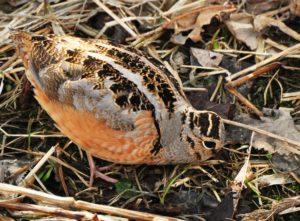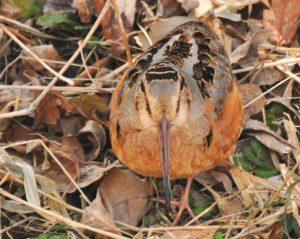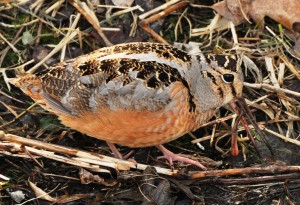Photography courtesy of Lowell Washburn, all rights reserved.
The stage is set. The house lights are dimming. Right on schedule, the evening performance begins. As the sunset explodes into a dazzling array of color, a solitary, quail-sized bird launches from the forest floor. Spiraling ever higher, the sky dancer’s black silhouette soon hovers more than 300 feet above its woodland home. With the flight now at its zenith, the bird suddenly folds its wings and hurtles back toward earth in a breathtaking series of zigzaging maneuvers. Dropping through the treetops, the bird’s velocity remains unchecked; a fatal, high speed collision seems eminent. Then, at a mere split second before impact, the creature opens its wings for a perfect landing. Dropping its wings and fanning its short tail, the bird struts across the forest floor like some kind of miniature gobbler.
For those who have had the privilege of viewing the display, there is no question that the courtship antics of the American woodcock is one of the woodland’s most amazing spring rituals. The twilight performances actually begin on the ground as males emit a series of off key, nasal “peentings” — which is the woodcock’s version of spring bird song. Once the show takes to the air, peenting is replaced by a musical twittering produced by specialized wing feathers. The dazzling return to earth is followed by resumed peenting and more spiraling flights as males attempt to attract the attention of prospective mates.
Although woodcock routinely migrate through our state, most Iowans will never catch so much as a single glimpse of this reclusive denizen of the deep woods. Also known as Timberdoodle, the woodcock feeds almost exclusively on the earth worms obtained by probing moist forest soils with its ridiculously long bill.
Woodcock have small feet and delicately shaped pink toes. Some scientists have theorized that foraging birds utilize these slender appendages to detect the slightest underground movements of their prey. After observing the feeding behavior of the woodcock in the accompanying photographs, I have become a firm believer in that theory. Slowly and deliberately stalking across the forest floor, the bird would suddenly come to an abrupt halt. Assuming a statue-like posture, the Timberdoodle indeed appeared to be ’listening with its feet’. Suddenly plunging its bill into the soil, the bird would quickly pull out a wriggling worm which it promptly swallowed. A dozen probes produced a total of eleven earthworms. In even the best of habitats, this would seem to be a suspiciously high success rate if the diggings were simply random attempts.





 Tom Cope
Tom Cope Sue Wilkinson
Sue Wilkinson Susan Judkins Josten
Susan Judkins Josten Rudi Roeslein
Rudi Roeslein Elyssa McFarland
Elyssa McFarland Mark Langgin
Mark Langgin Adam Janke
Adam Janke Joe Henry
Joe Henry Kristin Ashenbrenner
Kristin Ashenbrenner Joe Wilkinson
Joe Wilkinson Dr. Tammy Mildenstein
Dr. Tammy Mildenstein Sean McMahon
Sean McMahon